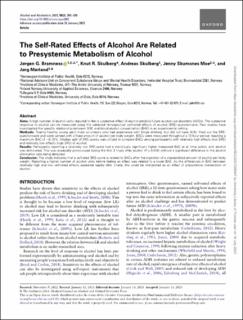| dc.contributor.author | Bramness, Jørgen Gustav | |
| dc.contributor.author | Skulberg, Knut Ragnvald | |
| dc.contributor.author | Skulberg, Andreas | |
| dc.contributor.author | Moe, Jenny Skumsnes | |
| dc.contributor.author | Mørland, Jørg Gustav | |
| dc.date.accessioned | 2023-10-25T10:43:00Z | |
| dc.date.available | 2023-10-25T10:43:00Z | |
| dc.date.created | 2023-04-13T12:12:21Z | |
| dc.date.issued | 2023 | |
| dc.identifier.citation | Alcohol and Alcoholism. 2023, 58 (2), 203-208. | en_US |
| dc.identifier.issn | 0735-0414 | |
| dc.identifier.uri | https://hdl.handle.net/11250/3098647 | |
| dc.description.abstract | Aims: A high number of alcohol units required to feel a subjective effect of alcohol predicts future alcohol use disorders (AUDs). The subjective response to alcohol can be measured using the validated retrospective self-rated effects of alcohol (SRE) questionnaire. Few studies have investigated the specific relationship between SRE and blood alcohol concentration (BAC) in an experimental setting. Methods: Twenty healthy young adult male volunteers who had experience with binge drinking, but did not have AUD, filled out the SREquestionnaire and were served with a fixed amount of alcohol per body weight. BACs were measured throughout a 12-hour period, reaching a maximum BAC of ∼0.13%. Median split of SRE-scores was utilized to compare BACs among participants with relatively high effects (low SRE) and relatively low effects (high SRE) of alcohol. Results: Participants reporting a relatively low SRE-score had a statistically significant higher measured BAC at all time points until alcohol was eliminated. This was especially pronounced during the first 2 hours after alcohol (P = 0.015) without a significant difference in the alcohol elimination rate being detected. Conclusion: The study indicates that a self-ated SRE-score is related to BACs after the ingestion of a standardized amount of alcohol per body weight. Reporting a higher number of alcohol units before feeling an effect was related to a lower BAC. As the differences in BAC between relatively high and low self-rated effects appeared rapidly after intake, this could be interpreted as an effect of presystemic metabolism of alcohol. | en_US |
| dc.language.iso | eng | en_US |
| dc.rights | Attribution-NonCommercial-NoDerivatives 4.0 Internasjonal | * |
| dc.rights.uri | http://creativecommons.org/licenses/by-nc-nd/4.0/deed.no | * |
| dc.title | The Self-Rated Effects of Alcohol Are Related to Presystemic Metabolism of Alcohol | en_US |
| dc.title.alternative | The Self-Rated Effects of Alcohol Are Related to Presystemic Metabolism of Alcohol | en_US |
| dc.type | Peer reviewed | en_US |
| dc.type | Journal article | en_US |
| dc.description.version | publishedVersion | en_US |
| dc.source.pagenumber | 203-208 | en_US |
| dc.source.volume | 58 | en_US |
| dc.source.journal | Alcohol and Alcoholism | en_US |
| dc.source.issue | 2 | en_US |
| dc.identifier.doi | 10.1093/alcalc/agad002 | |
| dc.identifier.cristin | 2140549 | |
| cristin.ispublished | true | |
| cristin.fulltext | original | |
| cristin.qualitycode | 1 | |

